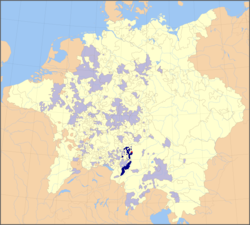Prince-Bishopric of Augsburg
Prince-Bishopric of Augsburg Fürstbistum Augsburg | |||||||||
|---|---|---|---|---|---|---|---|---|---|
| c. 888–1803 | |||||||||
 Augsburg territory (blue) in 1648 | |||||||||
| Status | Prince-Bishopric (State of the Holy Roman Empire) | ||||||||
| Capital | Augsburg (until 1276) Dillingen an der Donau | ||||||||
| Government | Elective theocratic monarchy | ||||||||
| Historical era | Middle Ages | ||||||||
• Bishopric established | 4th century | ||||||||
• Established | c. 888 | ||||||||
• Disestablished | 1803 | ||||||||
| Population | |||||||||
• Estimate | 100,000 (approximately) | ||||||||
| |||||||||
The Prince Bishopric of Augsburg was a prince-bishopric of the Holy Roman Empire, meaning it was a territory ruled by a prince-bishop. Its territory included a large portion of the Diocese of Augsburg, which the Prince-Bishop only had spiritual power over.
History
[change | change source]The prince-bishopric was established in the city of Augsburg and its surrounding territory in the 4th century.
Around the year 888, Augsburg was granted Imperial Immediacy, a high rank given to a territory of the Holy Roman Empire with a high degree of autonomy.
In 1276, the City of Augsburg became a Free Imperial City, meaning that it was now separate from the rest of the Prince-Bishopric of Augsburg. This meant that the capital of the Prince-Bishopric was changed to Dillingen an der Donau.
From 1632 to 1635, the Prince-Bishopric of Augsburg was occupied by the Swedish Empire.
In 1803, as part of the German mediatisation, the Prince-Bishopric of Augsburg became a part of Bavaria.
